Sushi, a dish synonymous with Japanese cuisine, has captivated the hearts and palates of food enthusiasts worldwide.
This delicate, vinegared rice and raw fish roll has evolved from humble beginnings to become a culinary masterpiece, symbolizing Japan’s rich cultural heritage.
You May Also Like: Carbonara Confidential: Uncovering the Rich History and Authentic Flavors of Italy’s Beloved Pasta
History of Sushi
Sushi’s origins date back to ancient Japan, around 2,000 years ago. The word “sushi” literally means “vinegared rice.” Initially, sushi was a simple fermented rice dish used to preserve fish.
The fermentation process allowed the rice to break down the proteins in the fish, creating a unique flavor and texture.
Over time, sushi evolved, and new techniques emerged.
During the Edo period (1603-1867), sushi became a popular snack in Tokyo’s streets.
The introduction of fresh fish and various fillings transformed sushi into the diverse, exquisite dish we know today.
Types of Sushi
- Nigiri: Hand-formed sushi with a small ball of rice topped with raw or cooked fish.
- Maki: Rolled sushi with vinegared rice and fillings, often wrapped in seaweed.
- Sashimi: Raw fish sliced into thin pieces, served without rice.
- Temaki: Hand rolls, large and cone-shaped.
- Uramaki: Inside-out rolls with fillings wrapped in rice.
Ingredients and Preparation
Sushi’s simplicity belies its intricate preparation:
- Sushi Rice: Short-grain rice prepared with rice vinegar, sugar, and salt.
- Neta: Fresh fish, seafood, or vegetables used as fillings.
- Nor: Seaweed sheets used to wrap maki rolls.
- Wasabi: Pungent, green condiment made from Japanese horseradish.
Sushi Etiquette
Dining at a sushi restaurant requires respect for traditional customs:
- Use Chopsticks: Handle sushi gently, avoiding direct contact with your hands.
- Dip Correctly: Dip the fish side of nigiri into soy sauce, not the rice.
- Eat Mindfully: Savor each piece, focusing on flavors and textures.
Regional Sushi Specialties
Japan’s diverse regions boast unique sushi variations:
- Tokyo-style: Classic Edomae-style sushi, emphasizing freshness and simplicity.
- Osaka-style: Oshi-zushi, pressed sushi with fillings and rice.
- Hokkaido-style: Crab and seafood-centric sushi.
Modern Sushi Trends
Contemporary sushi chefs innovate while honoring tradition:
- Fusion Sushi: Blending Japanese techniques with international flavors.
- Vegetarian and Vegan Sushi: Creative plant-based options.
- Sustainable Sushi: Emphasis on eco-friendly seafood and locally sourced ingredients.
Conclusion
Sushi is more than a dish; it’s an art form, a cultural symbol, and a culinary journey. From its humble beginnings to its current global popularity, sushi continues to captivate and inspire.
Whether you’re a seasoned sushi enthusiast or a curious newcomer, this iconic Japanese dish invites exploration and appreciation.
References
- “The Oxford Companion to American Food and Drink” by Andrew F. Smith.
- “The Story of Sushi” by Trevor Corson.
- “Sushi: A Practical Guide” by Hiroshi Takahashi.
Fact Box
- Originated in ancient Japan around 2,000 years ago.
- Sushi rice is prepared with rice vinegar, sugar, and salt.
- Various types of sushi include nigiri, maki, sashimi, temaki, and uramaki.
- Fresh fish, seafood, and vegetables are used as fillings.
- Sushi etiquette emphasizes respect for tradition and mindfulness.










